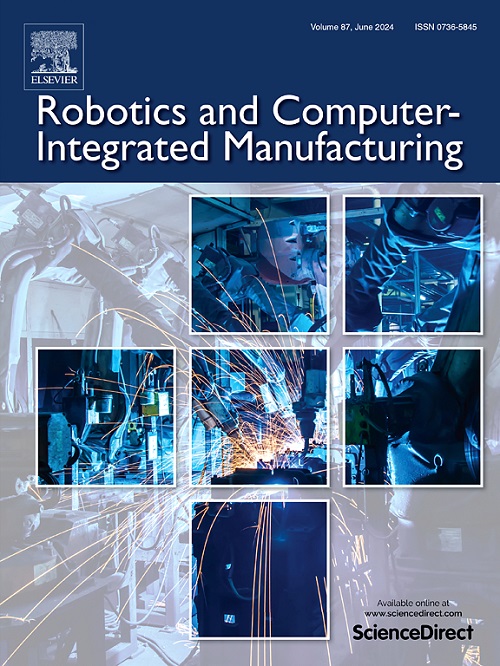A mixed reality-assisted scene-centric robot programming approach for human–robot collaborative manufacturing
IF 11.4
1区 计算机科学
Q1 COMPUTER SCIENCE, INTERDISCIPLINARY APPLICATIONS
引用次数: 0
Abstract
While mass personalization manufacturing paradigm increasingly requires robots to handle complex and variable tasks, traditional robot-centric programming methods remain constrained by their expert-dependent nature and lack of adaptability. To address these limitations, this research proposes a scene-centric robot programming approach using MR-assisted interactive 3D segmentation, where operators naturally manipulate the digital twin (DT) of real-world objects to control the robot, rather than considering cumbersome end-effector programming. This framework combines Segment Anything Model (SAM) and 3D Gaussian Splatting (3DGS) for cost-effective, zero-shot, and flexible scene reconstruction and segmentation. Scale consistency and multi-coordinate calibration ensure seamless MR-driven interaction and robot execution. Finally, experimental results verify improved segmentation accuracy and computational efficiency, particularly in cluttered industrial environments, while case studies validate the method’s feasibility for real-world implementation. This research illustrates a promising human–robot collaborative manufacturing paradigm where virtual scene editing directly informs robot actions, demonstrating a novel MR-assisted interaction method beyond low-level robot movement control.
面向人机协同制造的混合现实辅助场景中心机器人编程方法
随着大规模个性化制造模式越来越多地要求机器人处理复杂多变的任务,传统的以机器人为中心的编程方法仍然受到其依赖专家的性质和缺乏适应性的限制。为了解决这些限制,本研究提出了一种以场景为中心的机器人编程方法,使用磁共振辅助的交互式3D分割,其中操作员自然地操纵现实世界对象的数字孪生(DT)来控制机器人,而不是考虑繁琐的末端执行器编程。该框架结合了分段任意模型(SAM)和3D高斯喷溅(3DGS),具有成本效益,零拍摄和灵活的场景重建和分割。尺度一致性和多坐标校准确保了核磁共振驱动的无缝交互和机器人执行。最后,实验结果验证了分割精度和计算效率的提高,特别是在混乱的工业环境中,而案例研究验证了该方法在现实世界实现的可行性。本研究展示了一个有前途的人机协作制造范例,其中虚拟场景编辑直接通知机器人动作,展示了一种超越低级机器人运动控制的新型磁共振辅助交互方法。
本文章由计算机程序翻译,如有差异,请以英文原文为准。
求助全文
约1分钟内获得全文
求助全文
来源期刊
CiteScore
24.10
自引率
13.50%
发文量
160
审稿时长
50 days
期刊介绍:
The journal, Robotics and Computer-Integrated Manufacturing, focuses on sharing research applications that contribute to the development of new or enhanced robotics, manufacturing technologies, and innovative manufacturing strategies that are relevant to industry. Papers that combine theory and experimental validation are preferred, while review papers on current robotics and manufacturing issues are also considered. However, papers on traditional machining processes, modeling and simulation, supply chain management, and resource optimization are generally not within the scope of the journal, as there are more appropriate journals for these topics. Similarly, papers that are overly theoretical or mathematical will be directed to other suitable journals. The journal welcomes original papers in areas such as industrial robotics, human-robot collaboration in manufacturing, cloud-based manufacturing, cyber-physical production systems, big data analytics in manufacturing, smart mechatronics, machine learning, adaptive and sustainable manufacturing, and other fields involving unique manufacturing technologies.

 求助内容:
求助内容: 应助结果提醒方式:
应助结果提醒方式:


